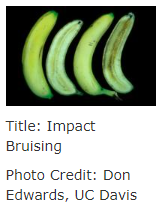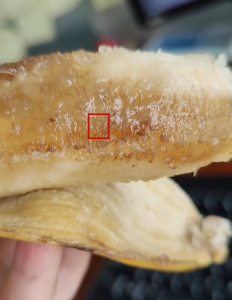發布日期 (HKT) 2023-05-29
Worms in banana are related to damage to banana peel, not to blackening of skin
Screenshot of the viral video.
The claim: A viral video circulating online shows microorganisms wriggling around on the soft, blackened banana flesh under a microscope. The caption claims that overripe banana flesh can harbor worms and is therefore unsuitable for consumption.
Fact-checking:
- The presence of worms in bananas is not directly related to the blackening of the fruit flesh, but rather to whether the banana skin has been damaged. The blackening of the flesh is a natural browning process that occurs when bananas ripen, or it could be the result of damage from impacts or falls, particularly when the banana is very ripe.
- According to Marshal Yuanshuai Liu, associate professor of chemical and biological engineering at the Hong Kong University of Science and Technology, the thick skin of banana serves as an effective protective layer, and it is only when the skin is damaged that there is a risk of worms breeding inside. The worms found in banana flesh are likely to be the larvae of fruit flies, hatched from eggs laid on the surface or in damaged areas of the fruit.
Our verdict: The worms in banana are not directly related to the blackening of the banana peel, but rather to whether the banana skin has been damaged. Therefore, we rate the claim as FALSE.
News Brief
Recently, a video has been circulating online, showing microorganisms wriggling around on the soft, blackened flesh of overripe bananas under a microscope. The caption warns against consuming blackened banana flesh, claiming that it can harbor worms.
As of the issuance of this report, the post had been reposted over 98,000 times, and had received 4,528 comments and 13,000 likes. Similar photos had been circulating on the Chinese social media platform Xiaohongshu.
Fact-checking
The blackening of bananas peel may be due to natural ripening-induced “browning” or physical damage.
Keyword searches found the blackening of banana peel is actually a result of the natural “browning” process. According to an article on the Encyclopedia Britannica, bananas produce a large amount of ethylene as they ripen, which causes the yellow pigment to break down into brown spots. When the fruit is bruised, this browning process is accelerated: the damaged banana produces even more ethylene, causing it to ripen and brown more quickly than an undamaged fruit.
According to the Market Inspection Instructions for Bananas from the U.S. Department of Agriculture, bananas gradually become softer as they ripen, making them more susceptible to damage and discoloration of the flesh, but without any obvious damage to the skin. The website of Postharvest Center, University of California, Davis (UC Davis) also mentions the same situation where the dropping of bananas may induce browning of the flesh without damage to the skin.
Impact bruising of bananas. (UC Davis/Don Edwards)
Based on an article on the website of Dole Food Company, the world’s largest fresh fruit and vegetable supplier, brown spots on bananas are actually a sign of ripeness, indicating that the starch has been converted into sugar, making them taste sweeter and providing the body with quick energy that is easy to digest. Even if there are some brown spots on the skin or flesh of bananas, they can still be consumed. The brown parts can be easily removed, and overripe bananas can also be used for making smoothies or ice cream.
The presence of worms in bananas results from the damage to banana peels.
Marshal Yuanshuai Liu, associate professor of chemical and biological engineering at the Hong Kong University of Science and Technology, responded to our inquiry and said that bananas that have been grown and stored properly are not easily infected by microorganisms or insects such as flies. The thick skin of bananas serves as an effective protective layer, and it is only when the skin is damaged that there is a risk of worms breeding inside.
Screenshot of the video published on Xiaohongshu, showing visible worms inside the banana flesh.
Liu mentioned that the visible worms found in the banana flesh (as shown above) are likely to be the larvae of fruit flies, which hatch from eggs laid on the surface or in damaged areas of the fruit. The hatching process typically requires suitable environmental conditions, such as appropriate temperature, humidity, and air, and it needs several days of development. If the banana skin remains intact, it is less likely for the eggs to hatch into larvae. Furthermore, he asserts that there should be no significant safety concerns in regards to consuming fruit fly larvae.
He also recommended that bananas should be stored in a cool, dry, and well-ventilated environment. Wrapping the stem of the banana with plastic film to cut off air contact can be an effective way to extend their shelf life. Unripe bananas should not be refrigerated, as low temperatures can impede the ripening process and damage the texture and flavor of the fruit. However, ripe bananas can be stored in the refrigerator for a short period to prevent over-ripening.
A related fact check was published Aug. 5, 2022, by HKBU Fact Check. It shows that the color of a banana’s stem cannot indicate whether it has been chemically ripened (click here to view the report).
Conclusion
The worms in bananas are not directly related to the blackening of the banana peel, but rather to whether the banana skin has been damaged. Therefore, we rate the claim as FALSE.
References
- Douyin, video, March 21, 2023.
- Xiaohongshu, video, May 8, 2023.
- Encyclopedia Britannica, “Why Do Bananas Turn Brown?”
- Dole, “Why do bananas go brown?”
- The U.S. Department of Agriculture, “Market Inspection Instructions for Bananas,” Apr. 2004.
- Postharvest Center, “Fruit Produce Facts English – Banana.”
- Marshal Yuanshuai Liu, the Hong Kong University of Science and Technology.
- HKBU Fact Check, “Banana stem’s color does not indicate whether it has been chemically ripened,” Aug. 5, 2022.















 :
: